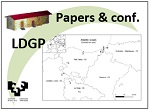Microvinifications in wild grapevine relic populations of Spain and France
Data
2020-12Egilea
Ocete, Carlos Alvar
Ocete, Rafael
Ayala, María C.
del Río, José María
Lara, Miguel
Hidalgo, Juanjo
Rodriguez-Miranda, Alvaro
Ocete, C.A., Ocete, R., Ayala, M.C., del Río, J.M., Lara, M., Hidalgo, Valle Melón, J.M., & Rodríguez Miranda, Á. 2020. Microvinifications in wild grapevine relic populations of Spain and France. Munibe, Ciencias Naturales - Natur Zientziak, 68. doi: https://doi.org/10.21630/mcn.2020.68.06
Laburpena
[ES] Se ha realizado la microvinificación de nueve poblaciones de vid silvestre euroasiáticas situadas en diferentes hábitats de La Rioja (España) y el País Vasco (España, Francia). Las poblaciones se observaron previamente en el momento de la floración para evaluar la presencia de ejemplares masculinos y femeninos. Ambas vendimias tuvieron lugar durante la última semana de octubre y la primera de noviembre de 2015 y 2016. Los racimos se despalillaron a mano seleccionando solo bayas maduras, se prensaron y se pesó la cantidad de mosto de cada muestra. La mezcla de mosto con semillas y pieles se fermentó a 20ºC con levaduras nativas sin adición de metabisulfito potásico.
El objetivo principal era conocer las principales características enológicas de estos vinos de vid silvestre. Debido al pequeño tamaño de las bayas y al hecho de que las semillas (1 o 2) son bastante voluminosas, el volumen de mosto obtenido es muy bajo en cada microvinificación (15,3 y 16,7% en peso). En 2015, mostraron valores más altos de concentración alcohólica, menor acidez total y mayor pH que en los vinos del año 2016, porque las bayas eran más maduras y saludables. Por otro lado, la concentración de etanol se sitúa entre
6,5 y 9%. En ambos años, los valores de acidez total son altos debido al alto contenido de ácido tartárico, situado entre 5,3 y 7,2 g / l. La intensidad del color de los vinos presenta valores altos, entre 15 y 23. Esto está estrechamente relacionado con el contenido elevado de antocianinas, entre 470 y 531 mg / l y el elevado índice de polifenoles totales, situado dentro del intervalo (65.8-107). En todas las muestras, ambos tipos de valores se consideran apropiados para vinos tintos jóvenes.
Estos vinos pueden sugerir que la vid silvestre es un recurso fitogenético muy interesante. Podrían cruzarse con variedades tintas de cultivo, con el fin de aumentar la acidez y la intensidad del color de los vinos. Estos son parámetros muy importantes en el marco actual de cambio climático, principalmente en regiones cálidas, como los viñedos mediterráneos. [EN] The microvinification of nine Eurasian wild grapevine populations situated in different habitats in La Rioja (Spain) and the Basque Country (Spain, France) were carried out. Populations were observed at flowering time in order to assess the presence of male and female vines. Both harvests took place during the last week of October and the first week of November in 2015 and 2016. Bunches were destalked by hand selecting only ripe grapes, pressed and the amount of must in each sample was weighed. The mixture of must with seeds
and skins were fermented at 20ºC with native yeasts without the addition of Potassium metabisulphite. The principal objective was to determine the main oenological characteristics of these wild wines.
Due to the small size of the grapes and the fact that their seeds (1 or 2) are quite bulky, the volume of must obtained is very low in each microvinification (15.3 and 16.7 % in weight). In 2015, they showed higher values of alcoholic concentration, lower total acidity and higher pH than with the wines of the year 2016 because berries were more mature and healthier. On the other hand, the ethanol concentration lies between 6.5 and 9%. In both years, the total acidity values are high due to the elevated content of tartaric acid, situated between 5.3 and 7.2 g/l. The color intensity of wines presents high values, between 15 and 23. This is closely related to the high content of anthocyanins, between
470 and 531 mg/l and the high total polyphenols index, within the interval (65.8, 107). In all the samples both kinds of values are considered appropriate for young red wines.
These wild wines may suggest that the wild grapevine is a very interesting phytogenetic resource. It might improve the acidity and color intensity of wines by crossing with red cultivars, a very important characteristics in the present context of climatic change, mainly in warming regions, such as the Mediterranean vineyards.
 Itzuli
Itzuli

